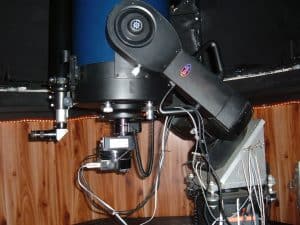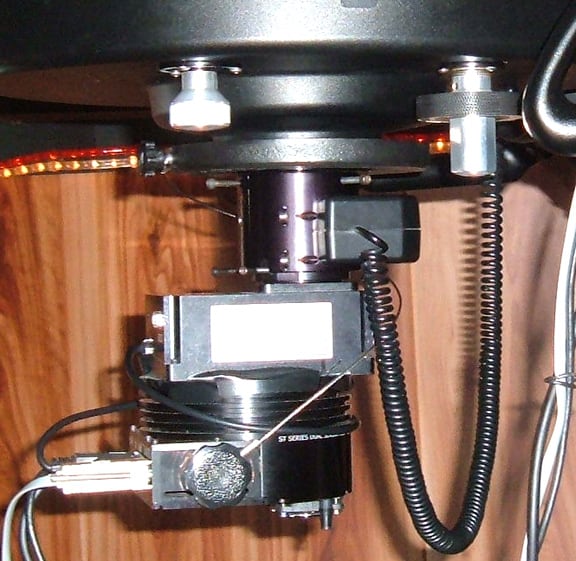
405 New Meadow Rd
Barrington RI 02806 USA
Questions? Contact us at:
1-401-245-4068
info@petersonengineering.com
Meade Telescope Camera Mounting Setup using the EyeOpener
This is Pete’s personal observatory setup for astrometry down to 20.7 magnitude.

Configuring an SCT’s optical train using a focal reducer can be challenging. There are two problems: Vignetting and Backfocus. The solution shown here solves these problems with the EyeOpener and a modified focal reducer.
In general, the EyeOpener will simply attach Meade’s Microfocuser to the scope backplate. When using the EyeOpener there is no loss in backfocus distance. And since vignetting can be a problem with all but the smallest CCD chips, some camera makers actually recommend use of an EyeOpener.
Due to it’s incredible sensitivity I’m using SBIG’s ST-8XME – complete with CFW-9 and AO-8.
When using the SBIG filter wheel and the adaptive optics unit I could not achieve focus when using an f/6.3 focal reducer. But to approach the Nyquist ideal of 2 arc-seconds per pixel coverage I needed a focal reducer.
This is my current observatory setup:

An EyeOpener II is screwed onto the backplate of the 14″, and Meade’s microfocuser is attached to the EyeOpener.
The optics from an older Meade f/6.3 focal reducer (one with a long 230mm focal length) were remounted so that instead of having the focal reducer as a separate space-consuming component in the image train the focal reducer glass is positioned completely inside Meade’s microfocuser. (Optec has modernized this Agos design and offers a Lepus focal reducer that achieves the same thing.)
The female thread on the SBIG AO-8 adaptive optics unit engages the male thread of the modified focal reducer. Since even a neutral density filter reduces light throughput by 50%, and since my objective is to achieve maximum sensitivity for astrometry, the SBIG filter wheel was set aside. And the SBIG ST-8XME camera is attached directly to the AO-8. (There’s some tape around the edges as there was some light leakage.)
With the EyeOpener in place vignetting is minimal. Even the off axis CCD guide chip in the camera is brightly illuminated.
Spacing between the focal reducer and the camera chip surface has been adjusted to achieve an effective focal ratio of f/6.2 – which brings the setup very close to Nyquist’s optimal 2 arc-second pixel coverage with 2X2 binning. To date the above setup has gone as deep as 20.7 magnitude.
Note that the camera has been inverted to allow the optical tube to get within 17° of celestial north. The LX200GPS upper declination travel limit has been set to 72°. While this sounds large, it’s actually a very tiny piece of sky that’s uncovered and it’s never been a problem.
The setup without the focal reducer and filter wheel would look exactly the same as shown when at prime focus except it would be f/10. Internally, the modified focal reducer would be replaced by a male T-thread to 2-inch tube adapter section between the AO and the Microfocuser. And at prime focus, the filter wheel could be added to the optical train.
Wishing Star Observatory carries the Harvard/Smithsonian Minor Planet Center designation I15
Technical note regarding the AO-8: Even with the modified focal reducer, the optical train will not reach focus with both filter wheel and adaptive optics in place. But at prime focus everything can be used. The 14″ has been upgraded with Buck’s Gears. And with a PEC of approximately 10 arc-seconds, pinpoint images are achieved even at the native 3550 mm focal length.
Hope this is of some help with your developing your own imaging configuration.
Pete